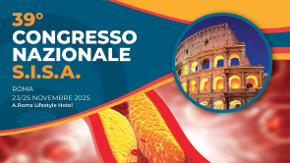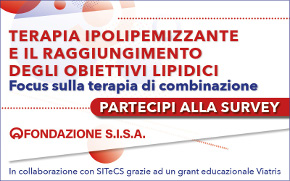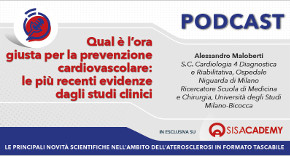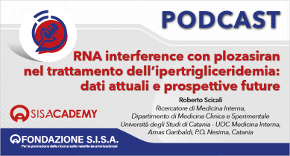 Rivista in lingua italiana
Rivista in lingua italiana
riservata ai Soci SISA
Ultimo numero:
Anno 16 • N.1/2025
Abstract
Lowering the triglyceride/high-density lipoprotein cholesterol ratio is associated with the beneficial impact of pioglitazone on progression of coronary atherosclerosis in diabetic patients: insights from the PERISCOPE Study
Nicholls SJ, Tuzcu EM, Wolski K, Bayturan O, Lavoie A, Uno K, Kupfer S, Perez A, Nesto R, Nissen SE.
J Am Coll Cardiol 2011;57:153-9
OBJECTIVES: The purpose of this study was to determine the factors associated with the favorable effect of pioglitazone on atheroma progression.
BACKGROUND: Diabetes mellitus is associated with accelerated coronary atheroma progression. Pioglitazone slowed progression compared with glimepiride in this population.
METHODS: In all, 360 diabetic patients with coronary artery disease were treated with pioglitazone or glimepiride for 18 months in the PERISCOPE (Pioglitazone Effect on Regression of Intravascular Sonographic Coronary Obstruction Prospective Evaluation) study. Coronary atheroma progression was evaluated by serial intravascular ultrasound. The relationship between changes in biochemical parameters, percent atheroma volume, and total atheroma volume was investigated.
RESULTS: Pioglitazone-treated patients demonstrated greater increases in high-density lipoprotein cholesterol (HDL-C) and reductions in glycated hemoglobin, triglycerides, and C-reactive protein. Significant correlations were observed between changes in percent atheroma volume and triglycerides (r = 0.15, p = 0.04), triglyceride/HDL-C ratio (r = 0.16, p = 0.03), and glycated hemoglobin (r = 0.16, p = 0.03) with pioglitazone, and changes in low-density lipoprotein cholesterol (r = -0.15, p = 0.05), apolipoprotein B (r = -0.16, p = 0.04), and apolipoprotein A-I (r = -0.20, p = 0.01) with glimepiride. Substantial atheroma regression, compared to progression, was associated with greater relative increases in HDL-C (14.2% vs. 7.8%, p = 0.04), relative decreases in triglycerides (-13.3% vs. -1.9%, p = 0.045), triglyceride/HDL-C ratio (-22.5 vs. -9.9%, p = 0.05), and decrease in glycated hemoglobin (-0.6% vs. -0.3%, p = 0.01). Multivariable analysis revealed that pioglitazone-induced effects on triglyceride/HDL-C were associated with changes in percent atheroma volume (p = 0.03) and total atheroma volume (p = 0.02).
CONCLUSIONS: Favorable effects of pioglitazone on the triglyceride/HDL-C ratio correlated with delayed atheroma progression in diabetic patients. This finding highlights the potential importance of targeting atherogenic dyslipidemia in diabetic patients with coronary artery disease.
J Am Coll Cardiol 2011;57:153-9

Area Soci
Eventi
39° Congresso Nazionale
 39° Congresso Nazionale
39° Congresso NazionaleRoma, 23-25 novembre 2025
Save the date




 Spring Meeting Gruppi Giovani SID, SIGG, SIIA, SIMI, SIPREC, SISA
Spring Meeting Gruppi Giovani SID, SIGG, SIIA, SIMI, SIPREC, SISARimini, 6-8 aprile 2025
[continua a leggere]
 SISA LIPID ACADEMY - Corso avanzato di lipidologia clinica
SISA LIPID ACADEMY - Corso avanzato di lipidologia clinicaModena, 4-5 Luglio 2024
[continua a leggere]Giornale Italiano Arteriosclerosi
HoFH today
 Rivista Italiana della
Rivista Italiana della
Ipercolesterolemia
Familiare Omozigote
Anno 6 • N.1/2024
Rivista NMCD
Diateca
[continua a leggere]
[continua a leggere]
Newsletter
il vostro indirizzo di posta elettronica
Progetto LIPIGEN

Nuovo sito dedicato al Progetto LIPIGEN
Progetto LIPIGEN - Vecchio portale
E' necessario essere loggati come utente
Lipigen per poter accedere alla pagina
PROject Statin Intolerance SISA
PROSISA – PROject Statin Intolerance SISA
E' necessario essere loggati come utente
PROSISA per poter accedere alla pagina
GILA - Lipoprotein Aferesi
Gruppo Interdisciplinare Lipoprotein Aferesi
(Accesso Gruppo GILA-Lipoprotein Aferesi)
E' necessario essere loggati come utente del Gruppo GILA per poter accedere
Gruppo Interdisciplinare Lipoprotein Aferesi
(Documentazione ad accesso libero)
Pagina informativa per medici e pazienti










